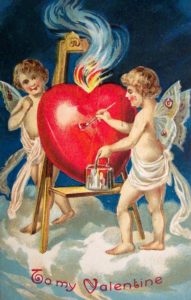Love it or hate it, Valentine’s Day is celebrated across the world as people come together to celebrate their loved ones. Many would regard the celebration as a relatively new phenomenon, known for its overindulgence in chocolate and flowers. However, the celebration has emerged from a spectrum of stories and traditions, that reveal a darker underside to the romantic celebration, steeped in Roman and Medieval tradition.

Similar to many celebrations across the globe, the true origins of the story are steeped in various legends. By far the most famous tale of Valentine’s Day stems from the celebration of Saint Valentine. Valentine is a saint honoured in the Catholic Church and Anglican Communion. Although there are multiple saints with the name ‘Valentine’, the one most commonly associated with the holiday of Valentine’s Day is Saint Valentine of Rome, who was a priest during the third century. Little is known about the life of Saint Valentine. However, legend has it that he performed secret marriages for Christian couples during a time when the Roman Emperor Claudius II had banned marriages, believing that single men made better soldiers. Subsequently, Saint Valentine was arrested, tortured, and executed for his defiance of the emperor’s order. From this perspective, Valentine’s Day is celebrated on February 14th to honour his sacrifice.
Another story, however, is of a soldier named Valentine, who was helping Roman prisoners escape. One story dictates that once imprisoned, Valentine frequently wrote to his lover. Just before his death, it is said that he signed a letter with ‘From Your Valentine’, a comment still used today! It is widely believed that in many countries, Valentine’s Day celebrates his death, rather than the Saint’s, dated in approximately the second century.
Other historians have suggested that Valentine’s Day comes from a deep-rooted Pagan Festival that takes place in February. Named Lupercalia, it was celebrated annually in ancient Rome on February 15th. The festival was dedicated to Faunus, the Roman god of agriculture and shepherds, as well as the Roman founders Romulus and Remus. It was a time of purification and fertility and was said to be a time when would put their names in a box to be drawn by men, and the couples would be paired off for the duration of the festival.
The Lupercalia festival also included sacrificing dogs for purification, as well as goats for fertility. The men would then parade around the town marking women with the sacrificed animals. Although this may sound gruesome, women would line up in anticipation of the ritual, as it was believed to help with fertility. Lupercalia was eventually outlawed as it was deemed ‘un-Christian’ by the 6th Century.
Fast forward to the Middle Ages, Valentine’s Day become more associated with love and encapsulated a more modern understanding. At the time, February was believed to be the mating season for birds, which added to the idea of romance. Such ideas were solidified by the famous poet, Geoffrey Chaucer, in his 1375 poem Parliament of Foules in which he suggested that Valentine’s be a day of romance. Furthermore, Shakespeare also brought to the forefront ideas of romance, by including Valentine Day’s in Hamlet and many more.
Eventually, Valentine’s Day made its way to mainstream discourse through the use of cards, which arrived during the 19th century, in the wake of the industrial revolution. This was primarily due to the creation of the penny post, whilst commodities such as chocolate had become accessible to the growing middle classes.







